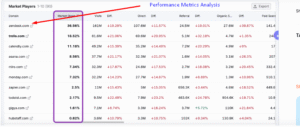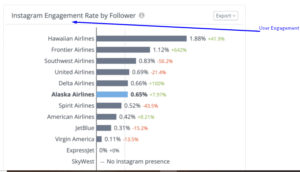
Competitor Benchmarking: What It Is And Why It’s Important
Competitor benchmarking of your brand will give you a clear idea how your brand is performing in the market in comparison to your competitors in the market. This will help you to create a road map for your future actions that can help in the growth of your business in future.
Unlike a broad competitor analysis, which examines overall strategies, strengths, and weaknesses, competitive benchmarking focuses on measurable data points like market share, website traffic, social media engagement, or operational efficiency.
The goal is to identify performance gaps, uncover best practices, and set realistic goals to improve your business’s competitive edge.
Table of Contents
- What Is Competitor Benchmarking?
- What Are The Advantages Of Competitor Benchmarking?
- Ways To Use Competitor Benchmarking
- Competitive Benchmarking Vs Competitor Analysis
- Five Step Guide For Competitor Benchmarking
- Social Media Competitor Analysis & Its Application
- Five-Step Guide for Social Media Competitor Analysis
- Applications Of Social Media Competitor Analysis
- Examples Of Competitor Benchmarking
- Conclusiong
What Is Competitor Benchmarking?
Competitor benchmarking is the process of comparing your company’s performance, processes, or strategies against competitors or industry leaders using specific, measurable metrics.
It focuses on data-driven comparisons, such as sales growth, website traffic, customer satisfaction scores, or operational efficiency, to identify strengths, weaknesses, and opportunities for improvement.
Unlike general competitor analysis, which broadly examines strategies or market positioning, competitive benchmarking zeroes in on quantifiable indicators to set clear performance targets.
For example, a software company might benchmark its app’s load time against a competitor’s to improve user experience, or a restaurant could compare its table turnover rate to industry averages to boost efficiency. The three main types are:
- Performance Benchmarking: Compares metrics like revenue, market share, or social media engagement.
- Process Benchmarking: Analyzes operational processes, such as supply chain logistics or customer service response times.
- Strategic Benchmarking: Evaluates broader strategies, like pricing structures or marketing campaigns.
What Are The Advantages Of Competitor Benchmarking?
Competitor benchmarking offers several advantages that help businesses improve performance and stay competitive. Here are the key benefits
1. Helps To Identify The Performance Gaps
By comparing metrics like sales, customer retention, or website conversion rates, benchmarking highlights where your business lags behind competitors, enabling targeted improvements. For example, a retailer discovering its checkout process is slower than competitors can streamline operations.
2. Drives Data Driven Decision
Benchmarking provides concrete data, such as industry averages or competitors’ social media engagement rates, to inform strategic choices rather than relying on assumptions. This ensures resources are allocated effectively.
3. Encourages Adoption Of Best Practices
Analyzing competitors’ processes, like their supply chain efficiency or customer service response times, allows businesses to adopt proven methods, enhancing operational effectiveness. It is essential for Competitors benchmarking for getting better insights about the market.
4. Set Realistic Goals
By understanding industry standards or top performers’ metrics, businesses can establish achievable targets. You must go through the competitor analysis example like an e-commerce platform can aim to match a competitor’s cart abandonment rate. Thus it can make your task easier in the long run.
5. Improves Competitive Positioning
Regular benchmarking reveals shifts in market dynamics, helping businesses stay ahead of trends and adapt strategies, such as refining pricing models to match competitors.
6. Boosts Innovation
Exposure to competitors’ strategies or technologies can inspire new ideas, like adopting a rival’s successful loyalty program or innovative marketing tactic. You can make an application of competitor benchmarking to boost your brand value to a greater level. Innovation is possible when you know the competition and the problems of your customers properly. This will help you to innovate products and services according to the market needs.
7. Enhances Customer Satisfaction
Comparing customer experience metrics, like Net Promoter Score (NPS), helps businesses identify areas to improve service, leading to higher customer loyalty. Competitor Benchmarking can help you in meeting your goals with complete ease. It can boost your scope to gain the maximum customer satisfaction. Competitor Benchmarking can make things work well for you.
Level Up Your Skills. Make Your Mark in the Digital Marketing Industry.Learn Practical Skills Directly from Industry Professionals |
|
| Advanced Digital Marketing | |
| More Learning Options for you: Google Ads Certification | Diploma in Digital Marketing | Facebook Ads Course |
Ways To Use Competitor Benchmarking
Competitor benchmarking can be applied in various ways to improve business performance by comparing specific metrics, processes, or strategies against competitors or industry leaders. Here are key ways to use competitor benchmarking effectively:
1. Performance Metrics Comparison
- What to Do: Measure quantifiable metrics like revenue, market share, customer retention rates, or social media engagement against competitors.
- Example: An e-commerce business compares its website conversion rate (e.g., 2%) to a competitor’s (e.g., 4%) to identify user experience improvements.
- How to Apply: Use tools like Google Analytics, SEMrush, or SimilarWeb to track competitors’ web traffic or engagement metrics, or analyze X posts for sentiment and reach.

2. Process Optimization
- What to Do: Benchmark operational processes, such as supply chain efficiency, order fulfillment times, or customer service response rates, to adopt best practices.
- Example: A restaurant benchmarks its average table turnover time (e.g., 45 minutes) against a competitor’s (e.g., 30 minutes) to streamline service.
- How to Apply: Study competitors’ workflows through industry reports, customer reviews on X, or direct observation (e.g., mystery shopping).

3. Pricing And Product Strategy Analysis
- What to Do: Compare pricing models, product features, or discount strategies to ensure competitiveness in the market.
- Example: A SaaS company benchmarks its subscription pricing against competitors to adjust tiers or offer competitive add-ons.
- How to Apply: Review competitors’ websites, promotional X posts, or third-party pricing aggregators to gather data.
4. Marketing And Branding Evaluation
- What to Do: Analyze competitors’ marketing campaigns, content strategies, or social media presence to enhance your own efforts.
- Example: A fashion brand compares its Instagram engagement rate to a rival’s to refine content or influencer strategies.
- How to Apply: Use tools like Hootsuite or Sprout Social to track competitors’ social media performance, or search X for their latest campaign posts.
5. Customer Experience Improvement
- What to Do: Benchmark customer satisfaction metrics like Net Promoter Score (NPS), complaint resolution times, or return rates to enhance service quality.
- Example: A telecom company compares its call center wait times to industry leaders to reduce customer frustration.
- How to Apply: Analyze customer reviews on X, Trustpilot, or Google Reviews to gauge competitors’ strengths and weaknesses.
6. Innovation And Technology Adoption
- What to Do: Study competitors’ use of new technologies or innovative business models to stay ahead of industry trends.
- Example: A retailer benchmarks a competitor’s use of AI chatbots to improve its own customer service automation.
- How to Apply: Monitor competitors’ tech announcements on their websites, X posts, or industry news via web searches.
7. Employee Performance And Training
- What to Do: Compare employee productivity, training programs, or satisfaction metrics to improve workforce efficiency.
- Example: A call center benchmarks its staff training duration against a competitor’s to reduce onboarding time.
- How to Apply: Use industry surveys or platforms like Glassdoor to compare employee satisfaction and training practices.
Few related topics for your knowledge
- 30 Important Strategies For Facebook Ads
- 30 Effective Link Building Strategies Of 2025
- 25 Effective Bid Strategies In Google Ads To Maximize ROI
- Zomato Marketing Strategy- A Detailed Case Study
- Steps For Creating A Landing Page For Lead Generation
- Game-Changing Important Strategies for YouTube Marketing Success
Competitive Benchmarking Vs Competitor Analysis
There are several points of differences between Competitive Benchmarking vs Competitor analysis. You must go through these differences to have a clear insight to it.
| Aspects | Competitor Benchmarking | Competitor Analysis |
|---|---|---|
| Definition | Comparing your performance, processes, or metrics against top industry players (not necessarily direct competitors) | Studying direct competitors to understand their strengths, weaknesses, strategies, and market position |
| Purpose | To identify best practices and performance gaps for improvement | To gain strategic insights and anticipate competitor moves |
| Scope | Broad – includes industry leaders, innovators, and even non-competitors | Narrow – focuses on direct competitors in your market |
| Focus Areas | Operational efficiency, customer service, product quality, etc. | Market share, pricing, marketing tactics, product features |
| Outcome | Internal improvements and strategic enhancements | Competitive advantage and tactical responses |
| Data Sources | Industry reports, benchmarking databases, case studies | Public financials, websites, customer reviews, marketing materials |
| Time Orientation | Long-term strategic improvement | Short- to medium-term tactical planning |
| Example | A retail brand benchmarking its supply chain against Amazon’s | A local café analyzing Starbucks’ pricing and promotions |
Five Step Guide For Competitor Benchmarking
You can follow the five step guide for competitor Benchmarking that can help your brand to meet your business goals with complete ease. Some of the core factors to cover here in this regard are as follows:-
1. Define Objectives & Metrics
Identify the specific goals of your benchmarking effort (e.g., improving efficiency, product quality, or customer satisfaction). Select key performance indicators (KPIs) such as cost, speed, revenue, or customer retention to measure against industry standards or competitors.
2. Identify Benchmarking Targets
Choose companies or industry leaders to benchmark against. These can include direct competitors, best-in-class firms (even outside your industry), or organizations known for superior processes. Ensure targets are relevant to your objectives.
3. Collect Data
Gather quantitative and qualitative data on your selected metrics from reliable sources, such as industry reports, public financials, customer reviews, or third-party tools like Statista or IBISWorld. For internal data, analyze your own performance metrics for comparison.
4. Analyze & Compare
Compare your performance against the benchmarking targets. Identify gaps, strengths, and areas for improvement. Use tools like gap analysis or SWOT to visualize differences and prioritize focus areas. Look for best practices that can be adapted.
5. Implement & Monitor Improvements
Develop an action plan to address gaps and adopt best practices. Assign responsibilities, set timelines, and integrate changes into your processes. Continuously monitor progress using the same KPIs to ensure improvements align with industry standards.
Social Media Competitor Analysis & Its Application
Social media competitor analysis is the process of evaluating your competitors’ social media strategies, content, performance, and audience engagement to gain insights that inform your own social media strategy. It involves analyzing their strengths, weaknesses, tactics, and market positioning across platforms like Instagram, Facebook, X, TikTok, LinkedIn, and others to identify opportunities, gaps, and trends. This helps businesses refine their approach, differentiate their brand, and stay competitive in a crowded digital landscape.

Five-Step Guide for Social Media Competitor Analysis
Below is a structured five-step guide tailored for conducting social media competitor analysis, building on the principles of competitive benchmarking but focused specifically on social media applications:
1. Set Clear Objectives And Metrics
Define what you want to achieve with the analysis (e.g., increasing engagement, growing followers, or improving content strategy). Select relevant KPIs to track, such as:
- Engagement rate (likes, comments, shares)
- Follower growth rate
- Posting frequency
- Content type performance (e.g., videos, reels, carousels)
- Audience sentiment (positive, negative, neutral)
- Example: If your goal is to boost Instagram engagement, focus on metrics like average likes per post or comment volume.
2. Identify Competitors
Pinpoint direct competitors (businesses offering similar products/services) and indirect competitors (those targeting the same audience or solving similar problems). Use tools like Hootsuite, Sprout Social, or manual searches to find competitors based on keywords, hashtags, or industry categories.
Example: A fitness apparel brand might analyze competitors like Nike and Lululemon (direct) and wellness influencers (indirect) to understand audience overlap.
3. Collect And Organize Data
Gather data on competitors’ social media performance using tools like Socialinsider, Rival IQ, or Hootsuite Analytics. Focus on:
- Content types (e.g., videos, images, stories)
- Posting schedules and frequency
- Engagement metrics (likes, shares, comments)
- Hashtag usage and trending topics
- Audience demographics and sentiment (via social listening tools)
- Example: Use Socialinsider to compare your Instagram engagement rate against a competitor’s and identify their top-performing post types.
4. Analyze and Identify Gaps
Compare your social media performance with competitors to uncover strengths, weaknesses, and opportunities. Conduct a SWOT analysis (Strengths, Weaknesses, Opportunities, Threats) to evaluate:
- What content resonates with their audience (e.g., video tutorials vs. static posts)
- Gaps in their strategy (e.g., underutilized platforms like TikTok)
- Unique tactics (e.g., influencer campaigns or user-generated content
- Example: If a competitor’s Reels generate high engagement but they rarely post on LinkedIn, you could prioritize LinkedIn to capture an untapped audience.
5. Apply Insights And Monitor Progress
Use insights to refine your strategy, such as adopting successful content formats, optimizing posting times, or addressing audience pain points competitors overlook. Implement changes and track your performance using the same KPIs. Set up ongoing monitoring with tools like Hootsuite Listening to stay updated on competitors’ moves and industry trends.
Example: If competitors’ customer service responses are slow, prioritize faster, more engaging responses to differentiate your brand.
Applications Of Social Media Competitor Analysis
The applications of Social media competitor analysis is huge. You just need to know the process to implement it in the correct order. So, you must get through this process to meet your goals with ease.
1. Content Strategy Optimization
Identify high-performing content types (e.g., videos, infographics, or polls) and adapt them to your brand. For instance, if competitors’ product demos drive engagement, create similar content tailored to your audience.
2. Audience Targeting
Understand your shared audience’s preferences, demographics, and pain points by analyzing competitors’ followers and interactions. This helps tailor content to meet audience needs and capture untapped segments.
3. Platform Prioritization
Discover which platforms competitors underuse or excel on. For example, if a competitor has a weak TikTok presence, you can focus efforts there to gain a first-mover advantage.
4. Improved Customer Engagement
Analyze competitors’ customer service responses (e.g., response time, tone) to enhance your own. Emulate effective tactics, like turning complaints into positive experiences, or address gaps they miss.
5. Trend Identification
Spot trending hashtags, topics, or formats competitors leverage to stay ahead of industry shifts. For example, adopting trending hashtags identified via Socialinsider can boost post visibility.
6. Benchmarking Performance
Compare your engagement, follower growth, and share of voice against competitors to set realistic goals and measure progress. Tools like Rival IQ provide leaderboards for easy benchmarking.
7. Strategic Differentiation
Identify competitors’ weaknesses (e.g., lack of video content or poor sentiment) to position your brand uniquely. For example, if competitors focus on paid ads, emphasize organic storytelling to stand out. Competitor Benchmarking can help you to understand the current status of your business in comparison to other businesses present in the market.
Examples Of Competitor Benchmarking
A small coffee shop chain conducts a social media competitor analysis and discovers that a competitor’s Instagram Stories featuring behind-the-scenes barista content drive high engagement. They implement similar Stories, track engagement with Socialinsider, and notice a 15% increase in follower interaction within a month. They also identify the competitor’s slow response to customer complaints on X and prioritize faster, friendlier responses, improving customer sentiment.
Conclusion
Hence, these are some of the crucial facts about competitors’ benchmarking that you need to be well aware of. You must follow the correct steps to become successful in your analysis process. This can boost the scope of your brand value to a greater level.
You can share your opinion with us regarding this matter. This will assist us to gain the correct insights to make things work well for you in the long run.
- LinkedIn Profile Optimization: A Simple Guide - October 10, 2025
- How To Boost Your Followers On Instagram: 30 Simple Strategies - September 26, 2025
- Types Of Google Ads:When & How To Use Them - September 19, 2025


